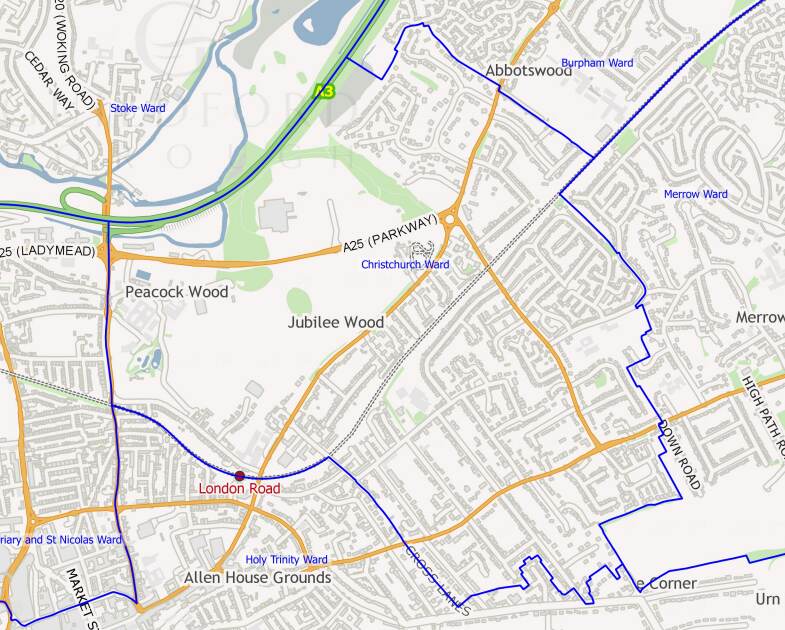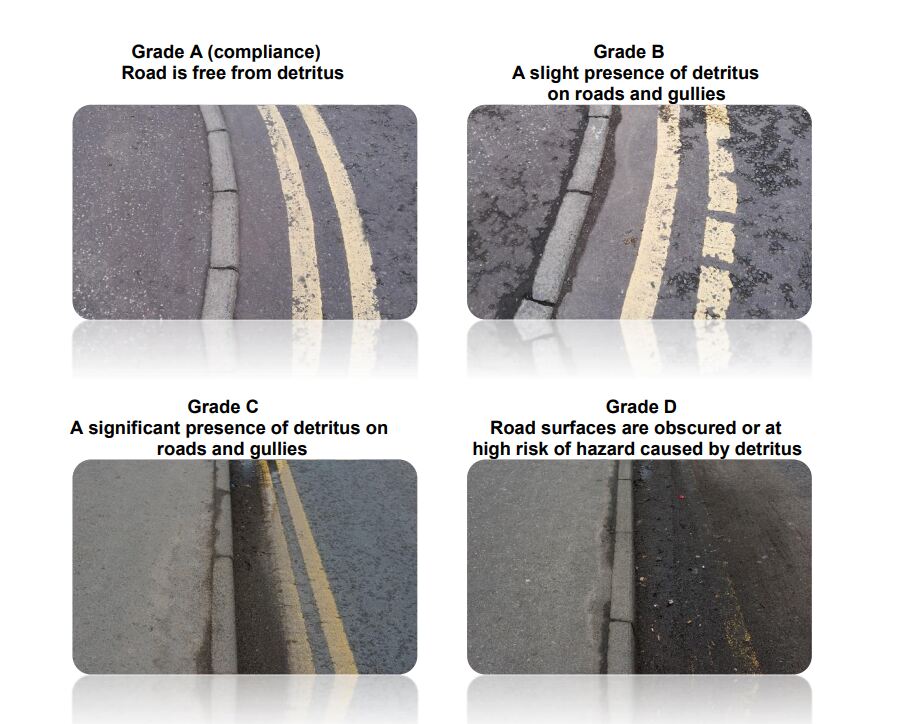Prior (Integrated Weed Management) Planning Prevents Poor Performance
When a council expresses the need to go glyphosate free, they need a detailed plan to back it up, not simply a replacement product.
Integrated Weed Management requires a plan.
Surface by surface, street by street, ward by ward, a plan must be constructed with enough detail to allow success.
If you fail to plan properly, you will be fighting a loosing battle against nature. Changing the built environment to ensure easier maintenance is a critical process.
A highway contains many elements that need to be thought through in order to reduce detritus build up and therefore weed growth. I want to take you through this planning step by step.
Councils are split into wards. Ward maps are very simple to obtain and can help to break down the planning into manageable chunks. Here is an example of a ward map for Christchurch Ward in Guildford.

Within this ward are many streets, with their own unique circumstances that must be documented and planned for.
In order to reduce weed growth, we should plan for each surface, on each street in the ward. Each section of highway or other surface to be maintained has several elements that must be included in the plan. Below is an example section of a highway with several elements.
A highway is maintained right up to the boundary fence line, hedge, front of house etc and includes the verge, footway and carriageway. All of this needs to be taken into account in a weed control strategy.

Let's take each section in turn.
Minimising weeds from the Boundary Line
The boundary line in the picture above is the fence.
First we could even consider what is behind the fence?
Is the fence an adequate barrier to prevent detritus from vegetation etc behind it from reaching the maintained surfaces? If not how can this be rectified?
Can the vegetation behind the fence be maintained at all to reduce detritus?
Is there adequate access to maintain the fence?
Minimising Weeds from the Verge
Is vegetation in front of the fence chosen in order to reduce detritus and also prevent damage to the fence? Can it be easily maintained? How will this be done?
We may at this point want to think about alternative plant species that would be easier to maintain and that will create less detritus.
Under the hedge plants there is grass verge in this example, which creates lots of detritus each time it is cut. Can this be replaced with another plant species to reduce detritus from clippings that will build up on the edge of the footway and carriageway?
Ground cover plants could make an excellent choice here;
This could also be designed to maximise biodiversity and reduce the cost of mowing. If not, can clippings be collected to prevent detritus build up on the hard surfaces?
Is the edge of the verge retained by any kind of barrier? If not we might want to think about doing so, as this will make sweeping or weed brushing the footway and carriageway much easier and help prevent arisings from migrating onto the footway or carriageway.
If a barrier exists, what condition is it in. Is there a crack between this and the footway or carriage way that is a trap for detritus. If so can this crack be cleaned out and sealed?
Minimising Weeds from the Footway
If the highway encompasses a footway, is this footway in good condition right up to the edge where it is supposed to meet a verge? If not can the condition be improved to reduce potholes, cracks etc where detritus can get trapped?
Slurry Sealing might be an option to improve the condition of the footway.
Is the footway clear of detritus, soil and weeds right up to the edge where it is supposed to meet the verge? If not, we can remove this detritus with a blower, sweeper or weed brush.
Minimising Weeds from the Carriageway
Is the carriageway in good condition right up to the edge where it is supposed to meet a verge or footway? If not can the condition be improved to reduce potholes, cracks etc where detritus can get trapped?
Is the Carriageway clear of detritus, soil and weeds right up to the edge where it is supposed to meet the verge or footway? If not, we can remove this detritus with a blower, vacuum, sweeper or weed brush.
Are the drains cleared out? Detritus from the drains could easily wash onto the surface in high volumes of water, especially if the drains are blocked.
It is a legal responsibility to keep the highway free of detritus, so reducing it in the ways set out above will make meeting this legal obligation (set out in section 89 of the Environmental Protection Act 1990) much easier.
Below is a detritus grading system to mark the condition of detritus on the carriageway or footway.
Grade A is acceptable. All other grades must be rectified in timescales which are set out in DEFRA's Code of practice for Litter and Refuse;

Treating Weeds with Heat
Once the above considerations have been made and maintenance tasks carried out, any remaining weeds can be easily treated with heat or another solution. Timing for heat treatments is critical in order to keep the weeds seedbank minimised.
When applying weed killer, we want the plant to be established with a broad leaf. When applying heat we want just the opposite - the earlier we can treat the plant the better. Ideally we want to be treating seedlings just as they are germinating and definitely before the plants go to seed again. Therefore treatment times will commonly take place in March and April, rather than May and June.
The Benefits of an In Depth Integrated Weed Management Plan;
If we take this planning seriously, we can save money in several areas as well as promoting more biodiversity.
By choosing slow growing hedges, trees and groundcover plants, with minimal leaf fall we can drastically reduce the cost of maintaining them as well as their destructive impact on the hard surfaces. We might go from 8 or 12 cuts with a mower, to one trim in a year. This not only saves money, but also provides a much better habitat for pollinators.
Plant choices can also reduce the detritus, leading to less frequent need for sweeping, and weed brushing operations. Less detritus means less soil build up for plants, which means less weeds to treat, reducing the applications of weed killer or other treatments. It will also mean less blocked drains to clear.
No comments yet. Login to start a new discussion Start a new discussion